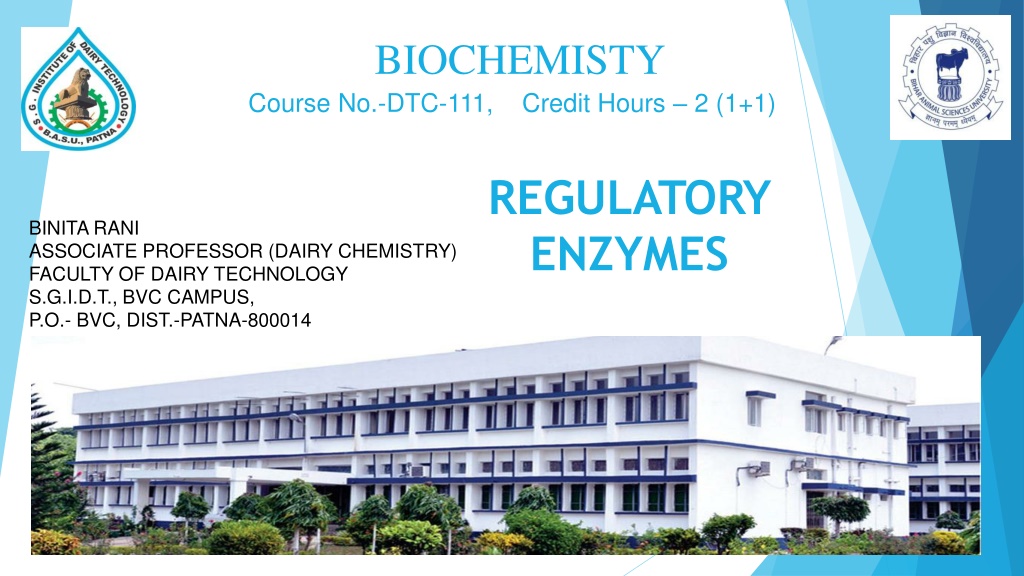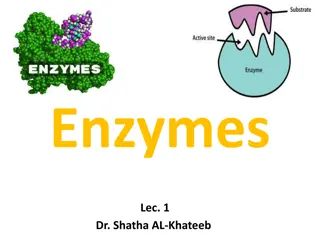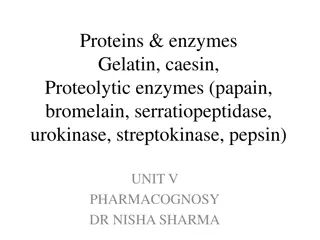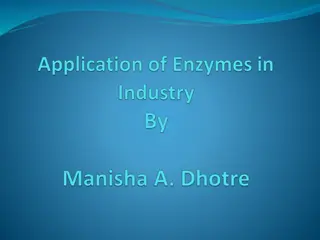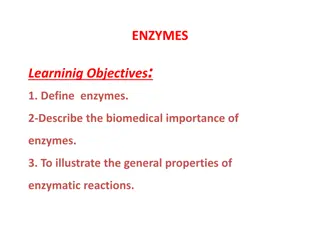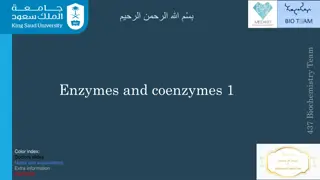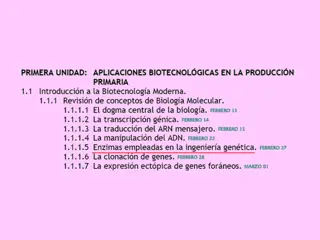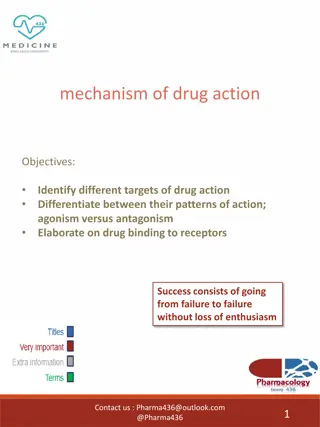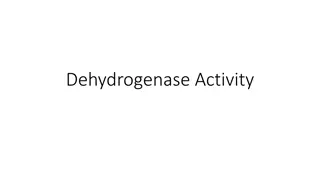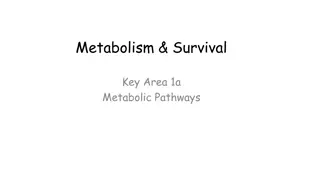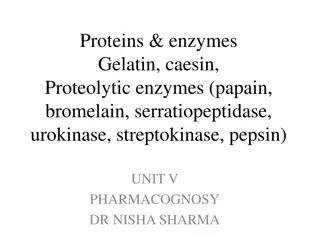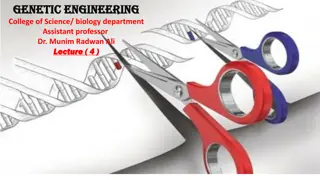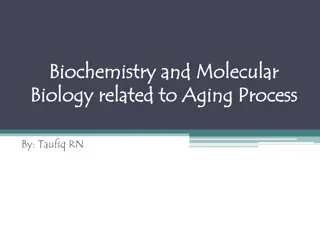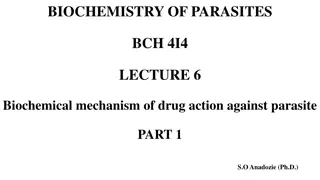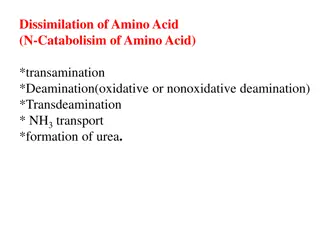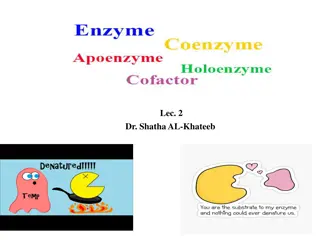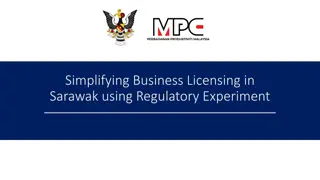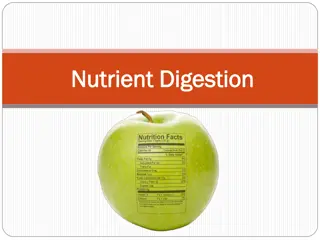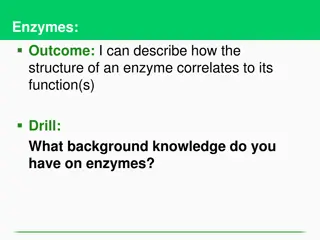Understanding Regulatory Enzymes in Biochemical Pathways
Regulatory enzymes play a crucial role in controlling the activity of biochemical pathways by responding to the presence of specific molecules. They regulate the pathway's activity, ensuring that products are produced in the required amounts at different times. This article delves into the significance of regulatory enzymes, their types including allosteric and covalently modulated enzymes, and how they influence the overall quantities of enzymes or concentrations of substrates present. By understanding regulatory enzymes, we gain insight into the intricate control mechanisms within biological systems.
Download Presentation

Please find below an Image/Link to download the presentation.
The content on the website is provided AS IS for your information and personal use only. It may not be sold, licensed, or shared on other websites without obtaining consent from the author. Download presentation by click this link. If you encounter any issues during the download, it is possible that the publisher has removed the file from their server.
E N D
Presentation Transcript
BIOCHEMISTY Course No.-DTC-111, Credit Hours 2 (1+1) REGULATORY ENZYMES BINITA RANI ASSOCIATE PROFESSOR (DAIRY CHEMISTRY) FACULTY OF DAIRY TECHNOLOGY S.G.I.D.T., BVC CAMPUS, P.O.- BVC, DIST.-PATNA-800014
A regulatory enzyme => an enzyme in a biochemical pathway which => through its responses to the presence of certain other bio-molecules => regulates the pathway's activity. This is usually done for => pathways whose products may be needed in different amounts at different times => such as hormone production. Regulatory enzymes are usually the enzymes => that are rate-limiting or committed step => in a pathway => meaning that after this step => a particular reaction pathway will go to completion.
Regulatory enzymes are => near initial steps in a pathway, or part of a branch point or cross-over point between pathways (where a metabolite can be potentially converted into several products in different pathways). In general => a cell needs to conserve energy => therefore costly (in metabolic terms) biosynthetic reaction pathways will not be operational => unless a particular metabolite is required at a given time. Regulatory enzymes control => overall quantities of enzyme or concentration of substrates present or => lead to alteration of catalytic efficiency of the enzyme.
Types of Regulatory Enzymes : Regulatory enzymes are of two types Allosteric enzymes Covalently modulated enzymes.
Allosteric enzymes Allosteric means => an additional space/site to => active site where => modulator (effector) molecule => interacts with enzyme. So allosteric enzymes have => additional site to active site where modulator interacts. The rates of enzyme-catalyzed reactions in biological systems are altered by => activators and inhibitors, collectively known as => effect or molecules or modulators. Interaction of modulator with enzyme is => reversible and non-covalent. Allosteric enzymes generally => have two or more polypeptides and are => more complex than non regulatory enzymes.
In allosteric enzymes => binding of a substrate molecule to one active site => affects binding of other molecules of substrate => to other active sites in the enzyme. Thus different active sites behave => cooperatively. Allosteric enzymes are => multi-subunit proteins => with one or more active sites on each subunit. Binding of substrate at one active site induces => a conformational change in the protein => that is conveyed to other active sites => altering their affinity for substrate molecules.
A plot of V0 against (S) for allosteric enzyme gives => a sigmoidal curve rather than the hyperbolic plots predicted by => Michaelis-Menten equation for non-regulatory enzymes. The sigmoidicity is thought to result from => cooperativity of structural changes between enzyme subunits (again similar to oxygen binding to hemoglobin). NOTE: A true Km cannot be determined for allosteric enzymes, so a comparative constant like S0.5 or K0.5 is used.
Curve has => a steep section in the middle of the substrate concentration. So there is a rapid increase in the enzyme velocity => which occurs over a narrow range of substrate concentration. This property makes => allosteric enzymes more sensitive towards substrate concentration. These enzymes are controlled by => effectors molecules or modulators (activator/inhibitor) => that bind to the enzyme at a site other than the active site(either on same subunit or on other subunit) => thereby causing a change in => conformation of active site which => alters the rate of enzyme activity.
in relation to multiple subunit enzymes => changes in conformation of one subunit leads to => conformational changes in adjacent subunits. These changes occur at => tertiary and quaternary levels of protein organization and => can be caused by an allosteric regulator.
Homotropic regulation => when binding of one molecule to a multi-subunit enzyme causes => a conformational shift that affects => binding of the same molecule to another subunit of the enzyme. Hetero tropic regulation => when binding of one molecule to a multi-subunit enzyme affects => binding of a different molecule to this enzyme (Note: These terms are similar to those used for oxygen binding to hemoglobin)
Feedback Inhibitions In metabolic pathway => end products often inhibits the committed step earlier in the same pathway to => prevent the buildup of intermediates and => unnecessary use of metabolites and energy and => the process is known as => feedback inhibition. End product inhibition is => negative feedback used to => regulate the production of a given molecule.
Feedback inhibition Initial substrate is a molecule => that is altered in three steps by enzymes 1,2 and 3. The end product will combine with enzyme 1 to => stop the reaction so => there will not be an excess production of the end product.
Reversible covalent modification It involves making or breaking of covalent bond between . => non protein group and an enzyme molecule. A range of nonprotein groups may be => reversibly attached to enzymes which => affect their activity. The most common modification is => addition and removal of a phosphate group called => as phosphorylation or dephosphorylation, respectively.
Phosporylation is catalysed by => protein kinases => using ATP as phosphate donar, and deposphorylation is catalysed by => protein phosphatases. Addtion and deletion of phosphate group causes => changes in tertiary structure of enzyme that alter => its catalytic activity. Serine kinases transfer => phosphate groups specifically to => serine residues on target enzyme. Similarly tyrosine kinases transfer phosphate groups => tyrosine residues of target enzymes and make them => active or inactive.
A phosphorylated enzyme may be => either more or less active than => its dephosphorylated form. Thus phosphorylation and dephosphorylation may be used as => a rapid, reversible switch to => turn a metabolic pathway on or off according to the needs of cell. For example glycogen phosphorylase => an enzyme involved in glycogen breakdown is active in => its phosphorylated form and glycogen synthetase => involved in glycogen synthesis is most active in => its dephosphorylated form.
Isozymes An enzyme which has => multiple molecular forms in the same organism => catalyzing the same reaction is known as isozyme. Example => Lactate dehydrogenase (LDH) LDH occur in => five possible forms in organs of most vertebrates => as observed by electrophoretic separation. Basically two different types of LDH occur. One type => which predominates in the Heart, is called heart LDH (H4). The second types are => characteristic of Muscles (M4).
Heart LDH consists of => four identical monomers which are called => H subunits. Muscle enzyme consists of => four identical M subunits. The two types of subunits H and M => have same molecular weight (35000) but different amino acid composition. There is genetic evidence that => two subunits are produced by two separate genes. Combination of H and M subunits will produce => three additional types of hybrid enzymes. These possible combinations are => M4, M3H, M2H2, MH3, H4. These various combinations have => different kinetic properties => depending on physiological roles which they perform.
